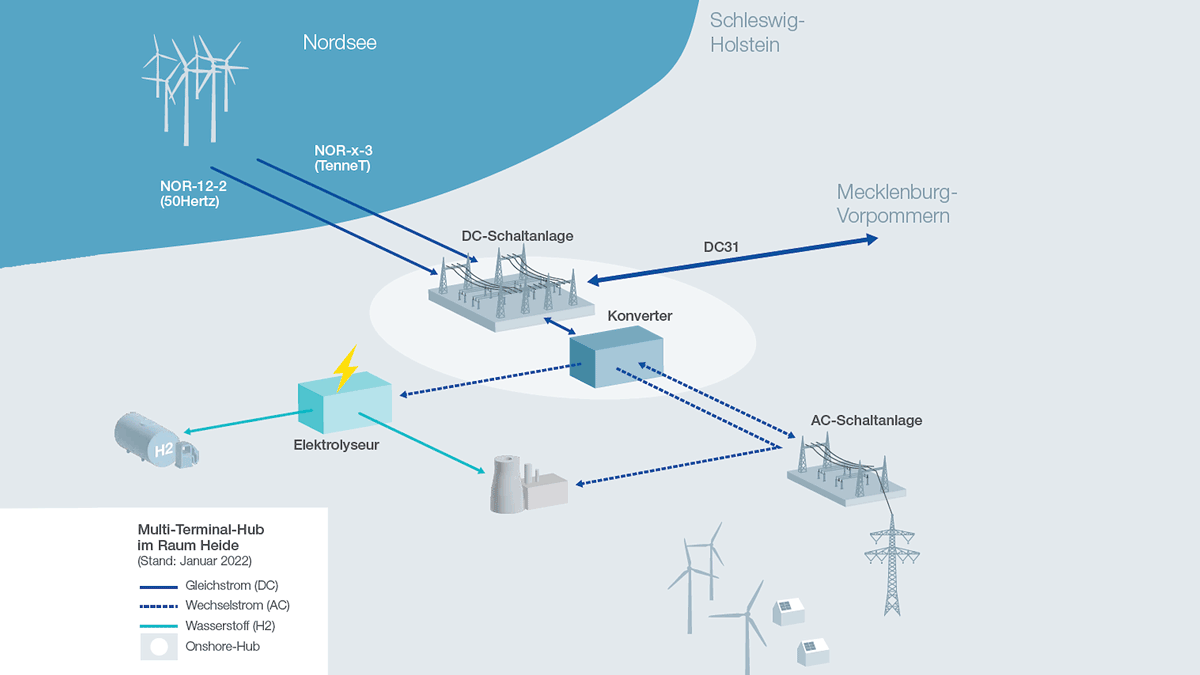50Hertz and TenneT to Bring Wind Power from the North Sea into the German Power Grid
50Hertz, formerly known as Vattenfall Europe Transmission and one of four transmission system operators for electricity in Germany, partners with TenneT, a Dutch transmission system operator, for the transportation of wind power from the North Sea into the German power grid. The two companies will realise the transmission via an innovative multi-terminal hub around Heide (Schleswig-Holstein) and an extra-high voltage direct current link (HVDC) to Mecklenburg-Vorpommern. The project is part of the 2035 grid development plan (2021) confirmed by the Federal Bundesnetzagentur (BNetzA).
“If Germany is to become climate-neutral by 2045, there must be even more focus on cooperation in the future. 50Hertz and TenneT are therefore working together and joining forces to tackle this challenging project to transport as much electricity generated at sea as quickly as possible to where it will be urgently needed in the future,” Stefan Kapferer, 50Hertz CEO, stated.
“With the joint implementation of the onshore hub in Schleswig-Holstein, TenneT and 50Hertz are laying the foundation for even higher utilisation of onshore DC lines while at the same time increasing the level of security of supply. In addition, the concept enables to accelerate the expansion of offshore wind energy, as envisaged by the new German government. With the implementation of the onshore hub and the three grid expansion projects linked to it, it will be possible to connect four gigawatts of offshore wind energy from the North Sea around Heide as early as 2032. This means that one part of the project will be completed three years and another even five years earlier than originally planned in the grid development plan,” Tim Meyerjürgens, COO of TenneT, added.
The joint project of the two companies consists of several components: In the area of Heide, 50Hertz and TenneT want to build the onshore multi-terminal hub for several direct current connections. It consists of an innovative direct current switchgear. This construction enables the direct and space-saving connection of two offshore direct current connection systems, each with a capacity of two gigawatts, with an onshore direct current link. In addition, a converter is connected to this plant, which converts direct current (DC) into alternating current (AC), which is then available in the region for planned offshore hydrogen electrolysers to decarbonize the industry located there, among other things. The converter can also be used to enable the transport of electricity generated by onshore wind turbines.
Between this multi-terminal hub and a converter in the area of Klein Rogahn near Schwerin, 50Hertz and TenneT plan to lay a direct-current underground cable around 200 kilometres long that will transmit electricity at the 525 kilovolt (kV) voltage level. 50Hertz will be responsible for the eastern section and TenneT for the western one.
The two offshore grid connection systems for the area of Heide confirmed in the just published grid development plan (Netzentwicklungsplan 2035/2021) will be implemented separately: the NOR-12-2 system will be connected to the multi-terminal-hub by 50Hertz and the NOR-X-3 system by TenneT.
Technically, the multi-terminal hub solution is an innovation as up to now, direct current connections at sea and on land have been realised as pure point-to-point connections. In the multi-terminal hub, however, several direct current connections converge. The electricity is fed into the transmission grid via DC or AC lines according to the corresponding transmission capacities and demand situations. Therefore, not three but only one AC/DC converter station has to be built in the Heide area. This reduces costs and land consumption on site – and furthermore helps to make load flows more flexible.



